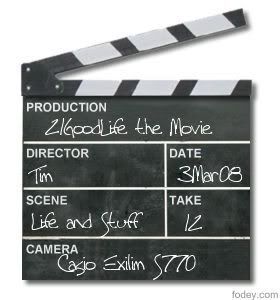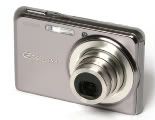Digital Lifestyle: Video Cameras
Stemming from a love of photography, I really got into video about 10 years ago. I was working as a system administrator in Warrington, and becoming perpetually bored, with what I perceived a mundane career. It wasn't 'that' mundane; I just didn't have any creative outlets. "Yeh maaaan!, whatever…" Anyway, so off I went, and did what I'm best at - research and learning. Within days, I was going to be the next Robert Rodriguez, and started to study film production and direction in my spare time. With my higher than average IT contractor wages, I was off buying expensive video kit; Canon GL1, matte boxes, Sennheiser mics and windshields, boom poles, tripods; you name it, I had it. God, I must have spent thousands. I ran out of steam though; as quite commonly I do; much to my wife's (girlfriend then) distaste - ah well! Still, I loved doing all the clever things with video. It was creative, but technically challenging. I got a real sense of satisfaction, cutting a home video in iMovie, adding soundtracks, and banging it out to a DVD in iDVD. But I'm a picky bugger these days in my old(er) age. My problem is, I won't commit to doing anything, until I've found the perfect way of doing it. I like to call it obsessive compulsive technology disorder - my digital life just 'has' to be in perfect order. About a year ago, I was examining my digital lifestyle creative outlets, and realised I'd not outputted any video for years. I used to love it so much; why did I stop? I soon found the answer. I absolutely hated carrying around a MiniDV camcorder with me. Even worse, was the fact that carrying a camcorder usually meant I had a stills camera with me also, not to mention the SLR. I decided enough was enough, and video was coming back to town. What I needed was a convergence device; an in the pocket device that would do a multitude of things, and good quality also. Convergence devices can be a right pain in the arse though, and tend to do a crap job at most things. It seems the more you add, the shitter they get. My phone had a camera and did video, and it did the phone bits, and the other data functions I needed it for, very well. The media quality was appalling though. Pocket cameras that shot video were a promising choice. I'd had a couple of these previously, and the video quality was pretty good. The problem was the format. Most pocket cameras these days shoot using the MJPEG format; and while it is good quality, the format is a pig. First off, it eats memory cards faster than a Labrador can eat a gravy bone. And secondly, once you have the AVI file, it's not the greatest format for sharing with. Also, frame sizes and rates used to be small, due to the high bitrates. And quality per Mb, it's not all that. Well, it's better for editing with - I suppose. But overall, it is outdated and behind the times. Sony's offerings include MPEG1 recording, and yes, you can fit loads on a card - shame it looks shit though. It seemed like video was going back on the shelf for a while. Or was it? It's no DV camera though. You can't zoom while recording, it'll only record up to 10 minutes on the EU version due to some EU legislative crap - used as a video recorder, more tax blah blah! The lens can flare quite badly, in direct bright light, but that's nothing out of the ordinary. The quality is superb considering this is a £170 camera, recording to MPEG-4. It records roughly 1.7GB per hour, that's about 140 minutes on a 4GB card. 4GB SD cards weigh in at about £15 these days. Because it records to SD memory cards, it's a cinch to get it onto your computer; none of this OHCI IEEE1394 camera control bollocks - just stick it in and go - nice! The files are AVIs, but that's just a wrapper like Quicktime MOV. The actual codec of the video is MPEG-4 Part 2, which is basically what DivX, XviD, Quicktime 6 etc use. This means that the files are widely playable on a whole host of devices. A lot of DVD players these days support MPEG-4 playback too, so it's easy to pop your files on a disc and play them on the big telly. Or, if you are like me, you can stream them across a network to a media player like XBOX Media Center (XBMC) or similar - more on that some other time. It was about 14 months ago that I bought this camera. As is life in the digital world, there have now been 45 million revisions of the product that I originally bought - sort of. Casio now offer an even more interesting proposition for video recording, in the form of MPEG-4 Part 10. It sounds like a really long drawn out movie sequel, but the format is also more commonly known as H.264, or MPEG-4 AVC. The format can be stunning. I've not seen the results from the new Casio cameras yet, but I'd imagine it to be better. The resolution is still only SD, but that's all I need for now, as the digital workflow around HD is just far too lengthy for simple home movies. On our recent trip to India, a brief sand storm almost totalled the lens contraction mechanism on our S770. A little devil on my shoulder secretly wants it to die a death, so I can upgrade to H.264 - don't tell Sally though :-) I told you I was obsessed with this stuff, and honestly, this is just the tip of the iceberg. Once you've decided on the video capture device you want, it's then time to start thinking about intended output. How do you get from capture to output, in the least fuss, in the least time, while still maintaining the picky (or in my case arsey) quality you desire? Well, I'll go into that in another entry soon.
 I was doing some heavy research on dpreview.com, as I'd seen some solid state memory MPEG-4 (part 2) recorders, and wanted to try to find a point and shoot that did the same. I came across the Casio range of cameras, and they appeared to have a whole line of cameras that recorded to MPEG-4. I trawled through countless reviews, and from what I could gather, the photo quality was average, but the video quality was good, more so considering the compression. They also did widescreen mode shooting, which I prefer, as my intended audience is 16:9. I settled on the Casio S770, as it was card sized, meaning it would go nearly everywhere with me, and most importantly wouldn't be a chore.
I was doing some heavy research on dpreview.com, as I'd seen some solid state memory MPEG-4 (part 2) recorders, and wanted to try to find a point and shoot that did the same. I came across the Casio range of cameras, and they appeared to have a whole line of cameras that recorded to MPEG-4. I trawled through countless reviews, and from what I could gather, the photo quality was average, but the video quality was good, more so considering the compression. They also did widescreen mode shooting, which I prefer, as my intended audience is 16:9. I settled on the Casio S770, as it was card sized, meaning it would go nearly everywhere with me, and most importantly wouldn't be a chore.

0 comments:
Post a Comment